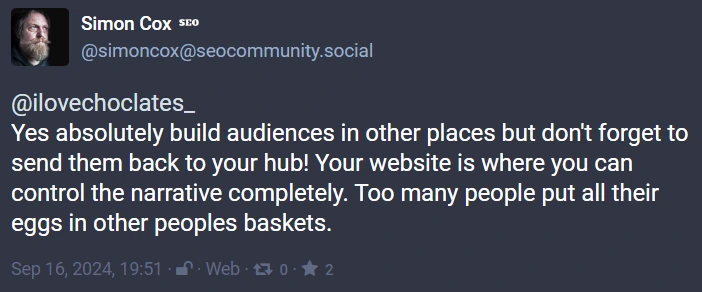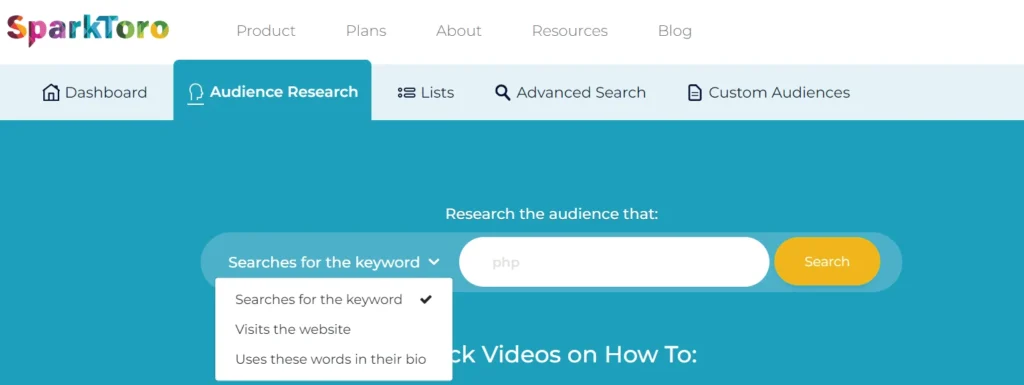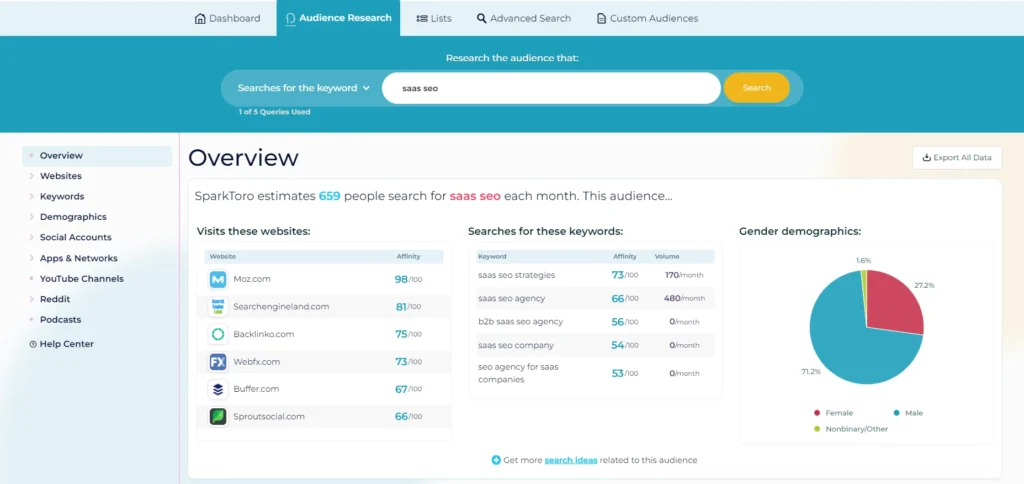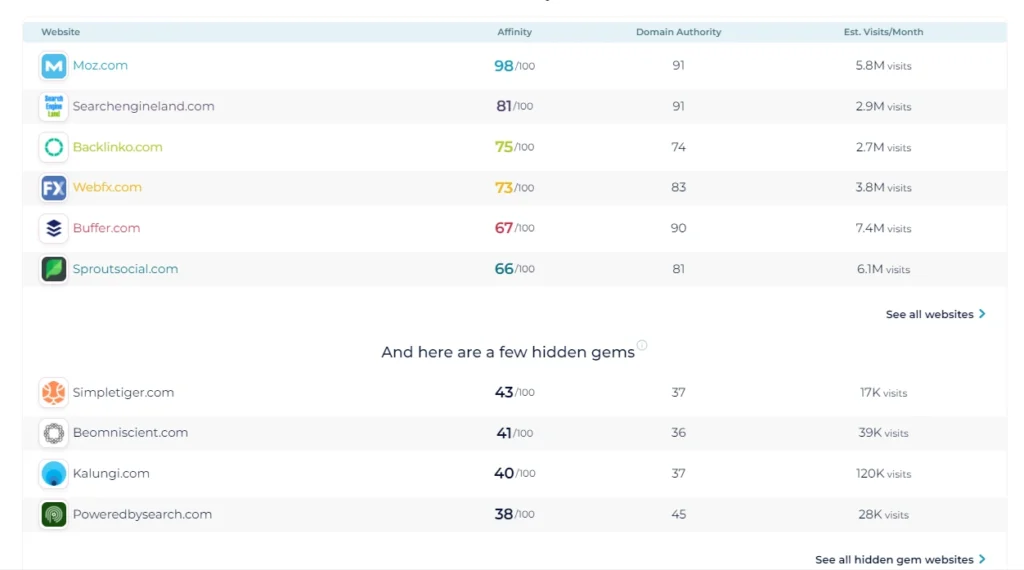Don’t just be on Google – Presentation from my BrightLocal Talk
I got an awesome opportunity to speak for the first time, and there could not have been a better place than BrightLocal Local SEO for Good.
There were so many amazing speakers (Shoutout to all of them!), and every speaker nominated a charity to which the funds would go. I nominated the Sanjay Gandhi Animal Care Shelter which is Asia’s largest animal shelter.
My talk was titled “User-friendly SEO: Shifting Focus from Search Engines to your users’ Needs”. The three main questions I talked about were:
- Why shouldn’t I be just on Google?
- Where else should I be? and
- How can it help me?
This post will dive a little deep and might cover all the things that I wanted to say in the 20-minute talk.
Table of Contents
Too Long; Didn’t Read
It’s important to diversify your web presence. You should be where your users are- which includes being on multiple platforms. It will help you build trust and even help you retain more customers. It’s time to move away from the traditional SEO practices to genuinely helping the users, creating content that helps them achieve their goals.
Here’s my slide deck.
What is user-friendly SEO anyway?
User-friendly SEO (you can also call it user-centric SEO) is an approach that prioritizes the needs and experiences of users over search engine algorithms. This approach is very different from the traditional SEO approach.
Ever since I got into SEO, I have seen how much people care about rankings, visibility, traffic, backlinks, and whatnot. I soon realized that most of what we do (as SEOs) does not care about our users. The content we aim for must be filled with keywords in all the strategic places and we must make 9000 backlinks to rank #1.
After all of this, we must do everything in our power to get indexed as soon as possible, and then continue to build backlinks to make sure that we rank well.
To some, this might sound like “traditional” or “old-school” SEO, but unfortunately, a lot of people do that every day. I would be lying if I said that I didn’t do all of that.
If you look at this from an outside perspective, do you realize something? And it’s that we never thought about the users in all of this (and more).
This just reminds me of this meme where websites are trying to please Google and never thinking about what their users actually want.

While I am here, let me drop a truth bomb: a lot of websites don’t know what their users want. They don’t know what to do to become more user-centric. And this makes me sad.
Coming back to what user-friendly SEO means, it’s just a term I made to describe that all of your SEO (or anything for that matter) should be centric to users. I sometimes interchange it with user-centric SEO.
The idea behind the term is that whatever you do with your web presence should have the users in mind instead of the search engines. The primary goal should be to become a website good enough to help the users, and then we can make small adjustments so that we get the maximum visibility on search engines.
This approach reverses what we are used to do as SEOs. Here’s what it looks like right now:
Create content → do on-page SEO → publish on website → get it indexed → Hope that it ranks → Hope that people click on it → Hope that we get business
And here is how I believe user-friendly SEO to be:
Understand users and what they need → create content based on that → Make sure that we are genuinely helping the users → Make small tweaks so that this content gets better visibility on search engines → Users find this content helpful → They buy and keep buying from you.
This approach means that the entire focus is on the users and solving their needs, not hoping that we create some random content and that it ranks well.
And because we are focusing on our users, part of that also means that we will create content that focuses on how we can help our users with our product. And this is a win-win for everyone.
Your users get what they’re looking for, and you get to showcase your product as a hero. This approach is hard to take in for a lot of people and I get that. But this is what I stand by and this is what I offer.
Why shouldn’t you just be on Google?
The reason why you shouldn’t just be on Google is that your audience is not just on Google. They’re everywhere. By not meeting them where they are, you are losing a lot of people and potential customers.
The one-line answer is that you shouldn’t put all your eggs in one basket.
On the other hand, one wise Simon said “Too many people put all their eggs in other people’s baskets.”

Let’s unroll both of these statements.
The first thing is that people don’t start and end their day with Google. (It was a little harsh, I know).
Who starts and ends their day with Google (and search engines in general?) SEOs do. (I think we’re the nerds lol)
Think about yourself for a second. Are you searching on Google all day long? (Trust me if you are, you need help. Just kidding). In an ideal world, you must be watching Netflix, scrolling through TikTok/Reels/Shorts, fighting with people on Reddit, looking for reviews on that new Pizza restaurant, and much more.
Now here’s a cool thing that you should know: people are coming across new brands and products on social media. Study shows that one in three consumers use social media to learn about or discover new brands, services, or products.
Now, idk about you, but I come across new brands on social media on almost a daily basis. For example, I got to know about Popflex, that Korean foundation brand, and even Stanley lol. And there’s no way that I would have gotten to know about these brands if they were not on social media (and if they hadn’t gone viral).
Take this as your first sign to not just be on Google.
The next thing (which is kinda related to the first point) is that people use different platforms for different purposes. For example, if someone wants to get inspiration for a DIY project or something, they’re more likely to go to Pinterest. And not just some people, but 85% of users say this.
Similarly, if someone wants to learn a new thing, they are more likely to go to YouTube for that. In fact, 86% of US viewers say so.
I personally have done this a lot of times. One of the reasons is that I learn better when things are visual, and sometimes a YouTube video is more in-depth than an article. And I personally have seen hour-long tutorials on YouTube than to read a 10,000-word article. Not to mention, I have learned about tons of new recipes by scrolling on YouTube, and whenever I want to make a certain recipe, my first place to go is YouTube.
I am sure you must have done something similar in your daily life. And your potential user must have also done this.
This just reinforces the fact that 1. your users are not just on Google, they’re everywhere, and 2. If you are not where they are, you are losing a lot of people.
Another reason why you shouldn’t just be on Google is that it takes a lot of time and authority to start ranking for the terms you want to rank for. The official existence of the “Sandbox effect” which is the probation period to keep the website ranking higher is not confirmed. However, from what I have seen from my experience, it really takes a while for Google to think that your website is worth showing in the results.
This can take up to 2 years (depending on the industry and how much authority it requires). So to see any meaningful results from SEO, you need at least two years. And if you’re just focusing on Google, this means that no visibility or engagement for your brand.
This leads to a different topic which is to not keep all the eggs in other people’s baskets.
There is a fine line between trying to build your web presence exclusively on social media platforms and building a seamless experience between all of the platforms.
Every day I hear stories of how people build a huge following on social media, only for them to ban/delete your account and then you have nothing left. If you follow people like Dan Koe, they say to have an email list because social media is not something you have control over. I think you should also add your website to that list too.
This really goes for all the platforms. You don’t want to be confined to a single platform. The only real way to get about user-centric SEO is that you need to be present on all the platforms where your users are and then funnel them to your website.
Your website should be the main point where they come after they discover you.
Let me put this into an example:
Mandy is a B2B SaaS company owner. With her team, she creates all sorts of content on YouTube, LinkedIn, podcasts, and more. In the content she creates, her main CTA is to try out the free version of the product on her website. This channels all of the traffic she generates into getting her audience to try out the free version of the product.
This is a very high-level example, but it should help you to understand what I am talking about.
The point is that you shouldn’t be dependent on one single platform- and this includes Google.
Where else should you be?
You should be where your users are. This means understanding where your ideal customers hang out and then creating content on those platforms. It’s important to start with one platform and expand your reach over time to avoid getting overwhelmed.
The main thing here is that you should be where your users are. I said above that a lot of websites don’t know what their users want. And because they don’t know what their users want, they also don’t know where their users are.
They don’t know of the platforms they hang out on, the podcasts they listen to, the subreddits they are active on, and more. And because businesses don’t have this information, it becomes hard for them to be where their users are.
This is where nailing down your Ideal Customer Profile (ICP) comes in handy. It helps you understand who your ideal customer is, and where they are most probably active.
So let’s say you get to know about your ideal customers. They are active in multiple subreddits, watch YouTube videos, scroll through LinkedIn, read newsletters, and more. How do you know which one is the most important?
Answers to questions like this come from knowing your customers. I would recommend doing calls with your existing top five or ten customers (that are more aligned with your ICP) to understand their behaviors.
If you see a lot of people mentioning a specific platform more, then you’d know which one to focus the most on.
Apart from talking with your customers, you can use a tool like SparkToro.
To use the tool, you can either search for the keyword your audience uses, or a website that they visit or use specific words in their bio.

And once you select that, you can just add the keyword and hit on search. It will tell you what keyword this audience uses, what websites they visit, their demographics, the social networks they use, what social media accounts they follow, podcasts they listen to, and more.

And I really like how it tells you not just the mainstream websites but also the “hidden gems”.

The idea behind knowing your customers’ behaviors and their top platform is that you can create helpful and insightful content that solves their problems.
It can get overwhelming trying to juggle twenty-five platforms at once, so this is why you want to start with one. And with time, you can expand your reach to more platforms.
Another thing related to tools you can do is use tools like PostHog and Hotjar to put out surveys on your website. In these questions, you can ask them things like what are the most common social media platforms they use, and open-ended questions to understand their online behavior.
All of this research should give you a lot of data to work with, and you can make your judgment based on that.
Another type of platform that I would recommend you to be on is the newer and the less common platforms (given that your target audience will be there). These new emerging platforms include Clubhouse, Bluesky, Mastodon, BeReal, and Threads by Instagram.
When you’re posting content on these platforms, it allows you to find a new audience and you will have a better chance of connecting with them. In other words, you will build brand awareness.
The next place where it is good to be is the location-specific platforms. These will help you especially when you want to cater to a local audience. If you have a physical location, I would highly recommend you be registered on directories such as Google Business Profile, Bing Places for Business, Yelp, and more. There are also platforms specific to countries, for example, in India, there are platforms like Justdial and IndiaMART.
The last place where I recommend you to be in the communities. This includes both online and offline communities. When it comes to online, you can join broad communities like Subreddits related to your niche and Quora. Or you can join industry-specific forums or communities.
Or you can make your own forum or community using Discord, Slack, or other platforms. This will give you a more personal way to connect with your audience.
When it comes to Reddit, I have a thing to say though. Google is favoring discussions/forum websites more on the SERPs, which is a great thing. But your goal to be in the communities should not be to manipulate Google or any other search engine. You want to be on Reddit because your audience is there and you want to build trust with them.
Whatever the platform is, the end goal is to be helpful, provide with useful insights, and get people to trust you.
How it can help you as a business?
Being more user-centric in your approach means you build trust with your users, and it also helps you retain those customers. It also helps you increase things like customer lifetime value.
The first and foremost thing it helps you with is retaining customers. And while we’re here, you might be interested in knowing that it is five to six times more expensive to find a new client than it is to retain an old client.
Another aspect where it can help is you are finding new audience segments and increasing your exposure. As I discussed above, people are using different platforms to come across new brands. And this is a good thing because you’re not just limited to the audience that’s coming through Google.
Apart from this, buyers these days are more likely to do their research before buying anything, and if you’re not where they want you to be, then it will become hard for you to convert them. In the 2019 Salesforce report, the State of the Connected Customer, it said that 67% of customers use multiple channels to complete a single transaction.
A similar study by Google says that 53% of shoppers say they always do research before they buy to ensure they are making the best possible choice. Stats like these just reinforce the fact that people are more likely to do their research from different platforms before they buy anything.

And how would you even ensure that you’re being a part of their research journey? By being where your users are and adapting omnichannel strategies.
It also increases the customer lifetime value (CLV). Because you’re providing experiences that are personalized and you are helping your users at every stage of the journey, they’re more likely to keep their relationship with your brand.
And all of this in the end increases sales. According to a study by Harvard, the more channels people use, the more they’re likely to spend compared to single-channel customers. How much? 10% more.
Tactical things you can do to become more user-centric in your approach
On your website
- Make sure that your website’s homepage tells your users what you offer in a simple, easy-to-understand language. There are a lot of times when I visit websites only to wonder what they do.
- Don’t have a ton of service pages just for the sake of it. If it’s not going to help your users, then it’s not going to help search engines either.
- If you have an About page, make sure that it actually tells about the company. Your potential client/customer might be interested to know how the company started, who started it, and who are the people behind this company. They might also be interested in knowing what are the values and ethics you stand for
- You don’t really need a contact page if all you’re going to add to it is a single email. You can probably add it in the top navigation (header) or the bottom navigation (footer). Use your contact page to actually provide different ways for people to contact you.
- On your article pages, include media such as images, infographics, videos, and charts so that the content gets more interesting. You can also include schema, especially on the important pages to provide structured information to search engines about your things.
- It’s really good to have certain pages (especially if you’re a SaaS website). For example, comparison pages, alternative pages, and even pages like discount pages. Case studies pages also help people make decisions.
- Leverage 404 pages because a lot of times people come across them. You can use this opportunity to get people to convert.
- Implement topic clusters. This helps you not only establish yourself as an authority in the eyes of Google, but it also helps people solve their problems.
- Create product-led content. This means creating content that uses the product to solve the problem a user has. This approach is miles better than trying to create SEO-led content where you find a keyword and make content on it.
- Add your unique perspectives, experiences, or anything that makes you stand out. People are looking to read content that is written by humans, and this is why they go to forums like Reddit. Real stories are imperfect, have flaws, and are vulnerable. Showcase that in your content. Try to get more emotions, rather than just making sure the content is perfect.
On your local presence
- The most easy thing one can do is to fill out all the missing information on your profile. I worked with this client who saw a huge growth (and rankings in the local pack) after they filled out all the missing information. Here are the ones that people tend to miss:
- Images of your interiors, or actual products
- Description of what your business is about
- Any social profiles
- Service areas
- Things like accessibility information, amenities, parking, service options
- Services and adding a description of that service. (please don’t keyword stuff them)
- Get people to add a review. One of the things that I see working with people is that as soon as you do your work, you ask your client if they had a good experience, and if they had, ask them a small favor and leave a review. Make it a frictionless process to leave a review. You can also put a QR code that directly takes people to the page where they can leave a review.
- NAP (Name, Address, and Phone Number) is a huge thing when it comes to local. So make sure that you have a consistent NAP throughout your web presence.
On social media platforms like Twitter, LinkedIn, Pinterest, Instagram
- At the start of your social media journey, you can pick the platform that your audience is most active on. You can run surveys or polls for this.
- You don’t have to make your profiles on all the platforms just for the sake of it. It’s not going to help you or your users. Make your profiles on the ones where you know you will be posting. Some people make the profiles just to claim the usernames, and I don’t know what to say to that lol.
- Don’t just post from the company account. It’s good to do that because you build awareness, but it doesn’t resonate with people because it’s not a human they’re interacting with. Consider putting a face on the branding and marketing. A lot of companies are being founder-led, which means that their founder is building a personal brand, and is the face of the company. You can also encourage your employees to start posting so that they can get the company recognized.
- Keep trying and experimenting with new formats because algorithms change a lot. You can’t expect to make the same kind of content even after a year. The one who changes and adapts will get to win.
- On LinkedIn, posting how-to content, carousels, and even opinionated pieces has got me a lot of following. At the time of writing this, LinkedIn is pushing videos. So to get more reach, you might want to include videos in your strategy. The other format I like (and do) is ‘how I’ content. This is me showcasing how I did a particular thing.
- The other thing with social media is that you have to be consistent. You don’t need to post every day but you need to post at a frequency that you are comfortable with. Social media algorithms favor fresh content more. So you need to keep that in mind.
- Don’t be afraid to repurpose your ideas (this also applies to other platforms like YouTube and your website). You can’t possibly come up with new ideas every single time. The only thing is that you need to take a different approach to repurposing than to simply copy paste from one platform to another.
On video-based platforms like YouTube
- The reason why I have kept YouTube separate is that YouTube is both a search engine and a social media platform. And I want you to think of YouTube more from a search engine perspective for playing the long game. Create videos that have relevance after a year or even 5 years.
- One of the great ideas for SaaS is to showcase their product and teach users how to use it. You can build a whole library with this content type, and you can embed this content on your website, and repurpose them to create articles.
- Share storytelling content like behind the scenes, what are you focused on, how are you planning things, and more. This makes people feel connected and resonated with you.
- The thumbnail and title are a huge thing when it comes to YouTube. People A/B test their thumbnails all the time, and they spend a significant amount of time on it. It will take a long time to master but don’t forget about this important thing.
- When it comes to writing the descriptions of the video, make sure you include a summary of the video and any important links.
Collaborating with other people in the industry
- The podcast is a great way to get yourself out there and build awareness about yourself. I personally have got all the podcast opportunities from posting on LinkedIn. You can also search for podcasts related to your niche and then ask if they’re open to collaborating.
- You can also choose to guest post for another website. (I am not talking about the spammy way of doing guest posts). For example, I got to write for Moz which I think is super cool.
- You can sponsor events, podcasts, and even YouTube videos. There is a whole side of advertising and people also do influencer marketing. This maximizes your reach and does it quickly compared to the organic.
For your email strategy
- If you can, build a lead magnet that solves one narrow problem fully. The traditional lead magnets don’t perform as much in my opinion. You can then make a whole lead funnel and get people to become more aware of your stuff.
- Sending regular newsletter editions is another great idea. You want to provide enough value so that the people don’t unsubscribe. I have seen companies talking behind the stuff with their product, sharing tips/hacks, and even curations from other people. In my opinion, curations only work for certain things, but not for everyone.
Forums, and communities
- A little note: Being in communities is not something you want to do just because Google is favoring it more. You want to do it because you want to help your users.
- It’s a great idea to join both online and offline communities. If you don’t have an offline community related to your industry, it’s a good time you build one. I have also seen brands organize entire conferences. This gets them a lot of recognition. For the online communities, being on Reddit and Quora is good as they’re large communities, but you should also be present in the small forums. Similar to the last point, you can build your own community or forum where people can ask questions
- The main aim behind the whole community thing is to answer questions, showcase your expertise, and build trust. Being salesy is not going to help you because it will get you banned and even make people think you’re too pushy (which is something you don’t want)
Final words
I really wanted to say all of this in that 20-minute talk lol. I am not joking. That story is for my personal website. Anyway, the main idea is that you shouldn’t just be on Google. Your website is probably the most important asset that you have, but it’s crucial these days to do things on top of writing articles. If you are not where your users are, then someone else will be there for them.
I hope that this deep dive gave you a few ideas that you can use to improve your web presence. And if you need help, you can always contact me.
